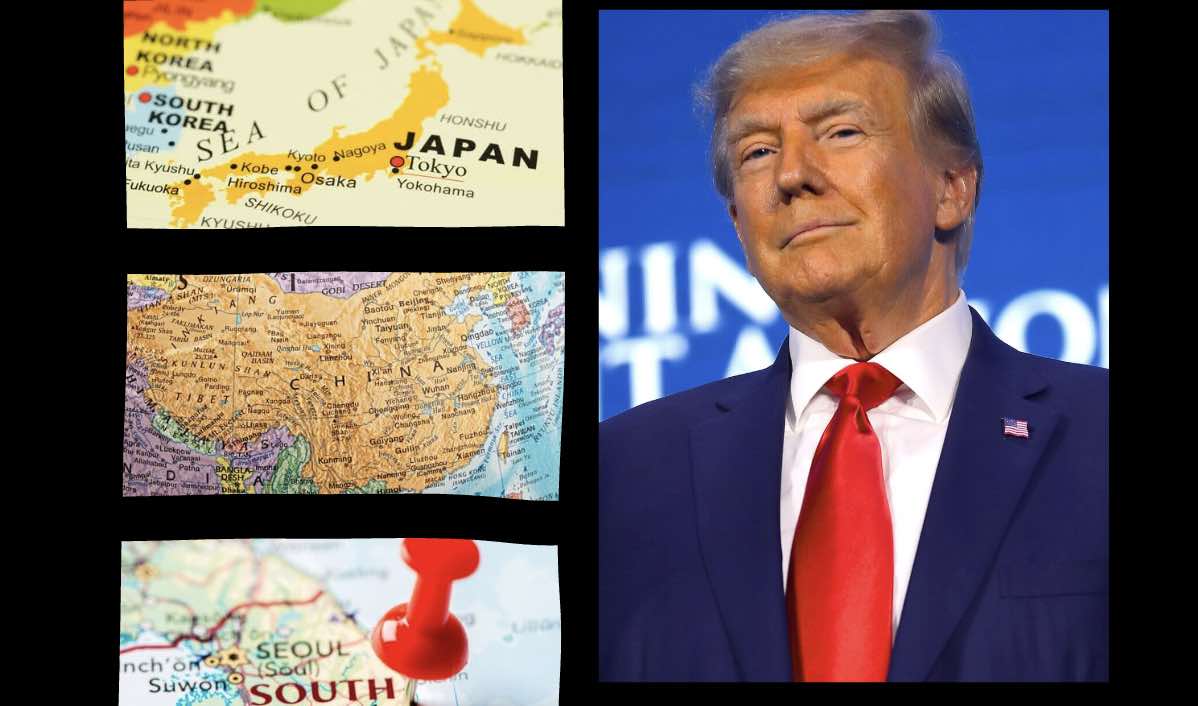President Trump’s newly announced “Liberation Day” tariffs have sparked strong reactions from China, Japan, and South Korea. These nations are moving quickly to counterbalance the effects of U.S. trade policies by strengthening regional cooperation. Trump’s reciprocal tariffs impose a minimum 10% tax on all imports and significantly higher rates on targeted nations, including China (34%), Japan (24%), and South Korea (22%). The global response has been swift and strategic, with these three economic powerhouses pivoting toward deeper collaboration.
What is “Liberation Day”?
“Liberation Day” is a term coined by President Trump to symbolize his administration’s aggressive push for economic independence from foreign reliance, particularly in manufacturing and trade. Announced as part of his new reciprocal tariff policy, Liberation Day marks the date when the U.S. implemented steep import taxes on goods from countries deemed to have “unfair trade advantages.”
How Each Country is Responding
| Country | Response to U.S. Tariffs |
|---|---|
| China | Plans to increase trade with Japan and South Korea, reduce reliance on U.S. exports. |
| Japan | Seeking alternative suppliers and expanding regional trade agreements. |
| South Korea | Strengthening economic ties with China and Japan to mitigate impact. |
China’s Strategy
China has been one of the hardest-hit countries by Trump’s tariffs. Having already faced years of economic pressure from previous trade wars, Beijing is accelerating its economic pivot away from reliance on the U.S. market. In response to the new tariffs:
- China has announced plans to increase trade volumes with Japan and South Korea, focusing on high-tech goods and essential commodities.
- The Chinese government is prioritizing domestic manufacturing of semiconductor chips, a critical component in many electronic products.
- Beijing is negotiating new trade agreements with other Asian and European nations to reduce dependency on American imports.
- Companies like Alibaba and Tencent are intensifying their efforts to expand operations in Africa and Latin America.
Japan’s Countermove
Japan, a key ally of the U.S., finds itself in a difficult position. While maintaining strong security ties with Washington, Tokyo is wary of the economic impact of Trump’s aggressive trade policies. Japan’s strategy includes:
- Expanding regional trade agreements through the Comprehensive and Progressive Agreement for Trans-Pacific Partnership (CPTPP) to cushion the impact of U.S. tariffs.
- Strengthening its economic ties with the European Union, which has also been targeted by Trump’s tariff policies.
- Investing in domestic production capabilities to lessen reliance on imported goods, particularly in the automotive sector, which faces a 25% tariff hike in the U.S.
- Collaborating with South Korea and China on semiconductor manufacturing to ensure supply chain stability.
South Korea’s Balancing Act
South Korea is particularly vulnerable to the tariffs due to its reliance on trade with both China and the U.S. In response:
- Seoul is working closely with Beijing and Tokyo to develop a regional trade pact that would allow for lower tariffs and reduced dependence on U.S. imports.
- South Korean automakers Hyundai and Kia are accelerating efforts to produce more vehicles for non-U.S. markets, with a focus on Europe and Southeast Asia.
- The South Korean government has announced incentives for domestic businesses to invest in local production and R&D.
- Consumer electronics giant Samsung is considering shifting part of its supply chain outside the U.S. to minimize losses.
The Bigger Picture: A Shift in Global Trade
The reciprocal tariffs could have far-reaching consequences beyond just Asia. Analysts warn that these measures will:
- Drive up costs for American consumers as businesses pass on the increased import costs.
- Weaken diplomatic relationships between the U.S. and its traditional allies, as economic conflicts spill over into political tensions.
- Accelerate China’s rise as a global trade leader, as the nation capitalizes on reduced American influence in global markets.
- Force businesses to rethink global supply chains, with many shifting operations to regions less affected by the tariffs.
What This Means for American Consumers
The direct impact of these tariffs will be felt in the wallets of American consumers. Several key sectors will see price hikes, including:
| Sector | Expected Price Increase |
|---|---|
| Automobiles | Up to $15,000 per vehicle for foreign-made cars |
| Electronics | 10-20% increase on items like smartphones and laptops |
| Retail | Clothing and household goods could see a 15% hike |
| Food & Agriculture | Imported goods such as wine, cheese, and seafood will rise by 10-25% |
The uncertainty surrounding these tariffs has already led to stock market volatility. The S&P 500 ended March with its steepest monthly decline in more than two years, as investors grapple with the potential economic fallout.
Could This Lead to a Global Recession?
Many economists warn that these tariffs could trigger a global economic slowdown. Jason Furman, a former chairman of the White House Council of Economic Advisers, described the situation as “a tax increase on American families” that could result in “lower economic growth, higher inflation, and increased unemployment.”
The European Union has also threatened retaliatory measures, potentially targeting major U.S. industries such as technology and finance. Countries across Asia and Europe are now exploring trade routes that bypass the United States altogether.
A Negotiation Tactic or Long-Term Strategy?
Trump has indicated that these tariffs might be flexible if foreign governments agree to make concessions. However, his stance has been unpredictable in the past.
“I’m certainly open to negotiation, if we can do something,” Trump said recently. “We’ll get something for it.”
For China, Japan, and South Korea, the lesson from previous trade disputes has been clear: Diversify and reduce dependence on the U.S. economy. As these nations forge stronger regional alliances, America risks being left out of crucial economic developments in Asia.
Key Takeaways
- China, Japan, and South Korea are working together to promote regional trade and lessen dependency on the U.S.
- A trilateral trade agreement is under discussion, with increased cooperation in semiconductor production and supply chains.
- China has committed to purchasing more products from Japan and South Korea to counterbalance U.S. tariffs.
- This could reshape global trade and impact American businesses reliant on imports.






